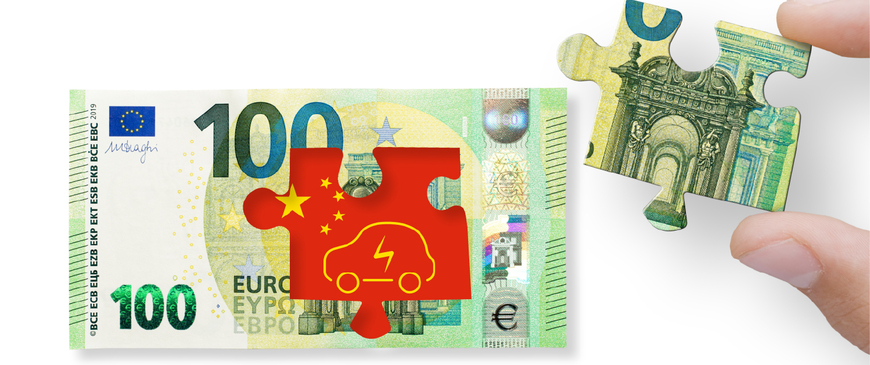
The EU's drive on China: What EV tariffs mean for Europe
The EU has imposed fresh tariffs on Chinese EVs. It has good reason to worry about Chinese subsidies, but it is unclear that the tariffs are the right answer to Europe’s lagging competitiveness.
Meetings of the EU’s Trade Defence Instruments Committee are rarely headline-grabbing affairs. But when representatives of the bloc’s 27 member-states convened in early October, a politically sensitive issue divided national capitals: tariffs on Chinese battery-powered electric vehicles (EVs). The vote passed narrowly thanks to member-states that abstained and – despite a last-minute attempt by Beijing to strike a deal – the EU ultimately imposed new tariffs of up to 35 per cent on Chinese EVs, in addition to the existing 10 per cent duty. This decision aligns the EU with other Western countries taking steps to counter what are perceived as unfair competitive advantages from years of generous Chinese industrial subsidies. However, it remains unclear whether the EU’s move will achieve the intended outcomes: increasing the price of Chinese imports into Europe and bolstering the competitiveness of the domestic car industry.
The EU imposed new tariffs of up to 35 per cent on Chinese EVs, in addition to the existing 10 per cent duty.
The EU has good reason to be concerned about Chinese EVs
The new tariffs, effective from October 30th, follow a nearly year-long investigation by the European Commission. While anti-subsidy probes are typically prompted by industry complaints, this investigation was launched at the Commission’s own discretion, signalling deep-seated concerns within the Berlaymont about Europe’s lagging competitiveness as Chinese industrial dominance rises. EVs have become emblematic of this struggle: Chinese car makers are seen to have reaped the benefits of years of substantial state support, enabling them to capture significant market share in Europe – often at the expense of local producers.
It is not hard to see why Brussels is concerned. Chinese battery EV imports have surged into the European market since 2020, growing by a staggering 1,646 per cent from 2020 to 2023, compared with a more modest 325 per cent growth in total battery EV imports into the bloc. In 2023, the EU imported nearly €11bn worth of battery EVs from China, accounting for nearly half (49 per cent) of all imports into the EU (Chart 1).
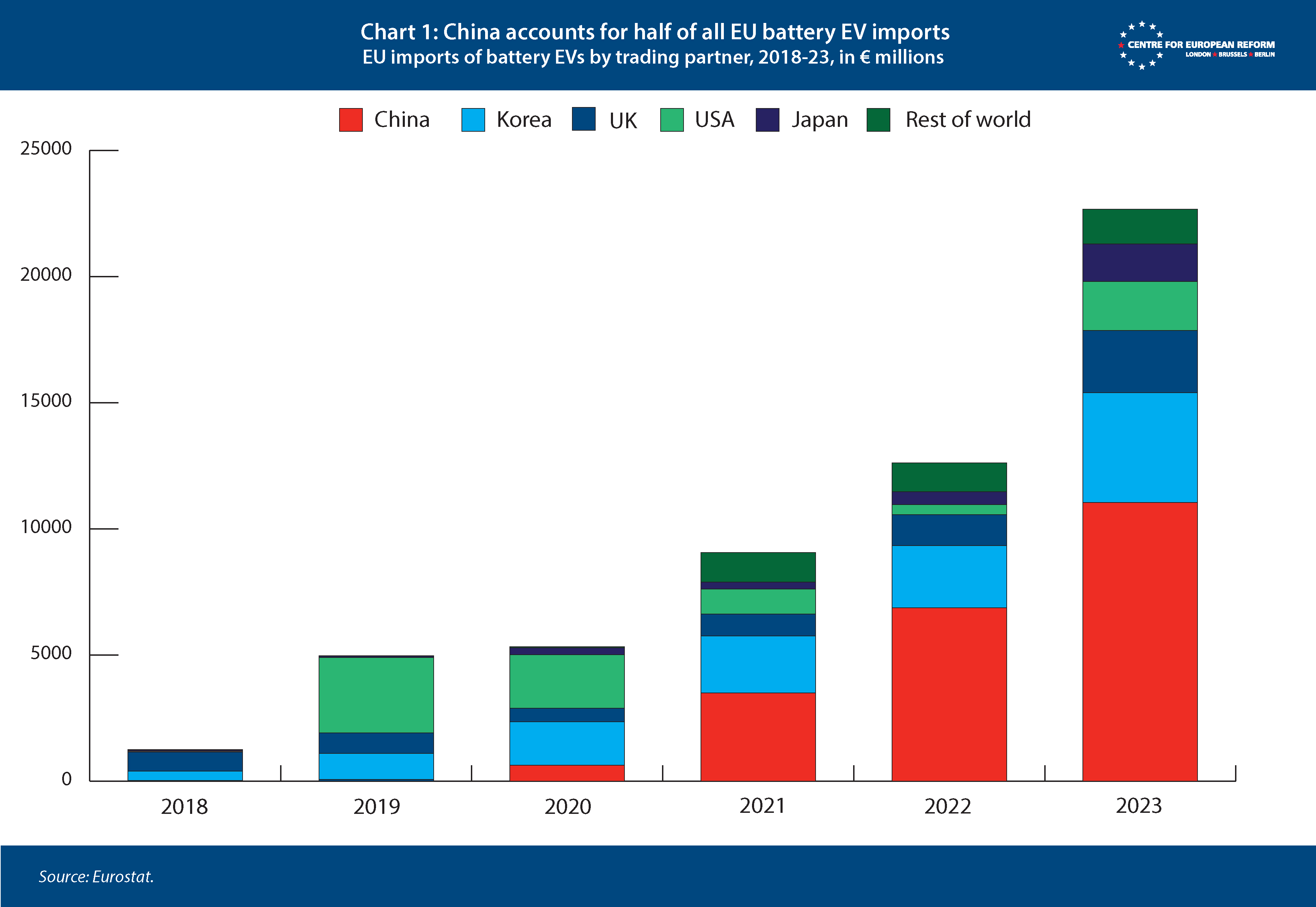
High import volumes alone do not prove unfair trade practices, so it is also instructive to consider the value of imports per vehicle. In 2023, the average Chinese battery EV imported into the EU was valued at just over €25,200 – 32 per cent lower than the price of non-EU imports (€37,130) and 16 per cent below the average price of battery EV imports (€30,200) (Chart 2). In anticipation of the EU’s decision, Beijing made a counterproposal for minimum price guarantees that would have set the import price to be at least $33,000, which the Commission rejected.
The cost of an EV is largely driven by the battery pack, which can make up to 30-40 per cent of production costs. The Commission’s investigation zoomed in particularly on the Chinese government’s support for battery production, with a primary concern that overcapacity in battery production has allowed batteries and raw inputs like lithium to be supplied to local manufacturers at below-market prices. Its conclusion was that this subsidy, along with other fiscal incentives, has enabled Chinese car makers to scale up domestic production capacity, export at lower prices, and undercut rivals in foreign markets.
Chinese government’s support for battery production has allowed batteries and raw inputs like lithium to be supplied to local manufacturers at below-market prices.
The EU’s tariffs are carefully calibrated. The imposed ‘countervailing duties’ differ across car brands, ranging from 7.8 per cent for Tesla to 35.3 per cent for SAIC, reflecting the varying levels of subsidy calculated for each producer (Chart 3). The tariffs specifically target battery EVs, leaving hybrid models, car parts, and battery packs unaffected. The Commission asserts that the objective of these tariffs, which are set for five years, is not to shut the door on Chinese imports but to “level the playing field” for European producers, giving them time to adapt to the evolving market landscape. The Commission is, however, keeping additional options open, including potentially broader tariffs on the import of lithium-ion batteries that have been surging into Europe from China.
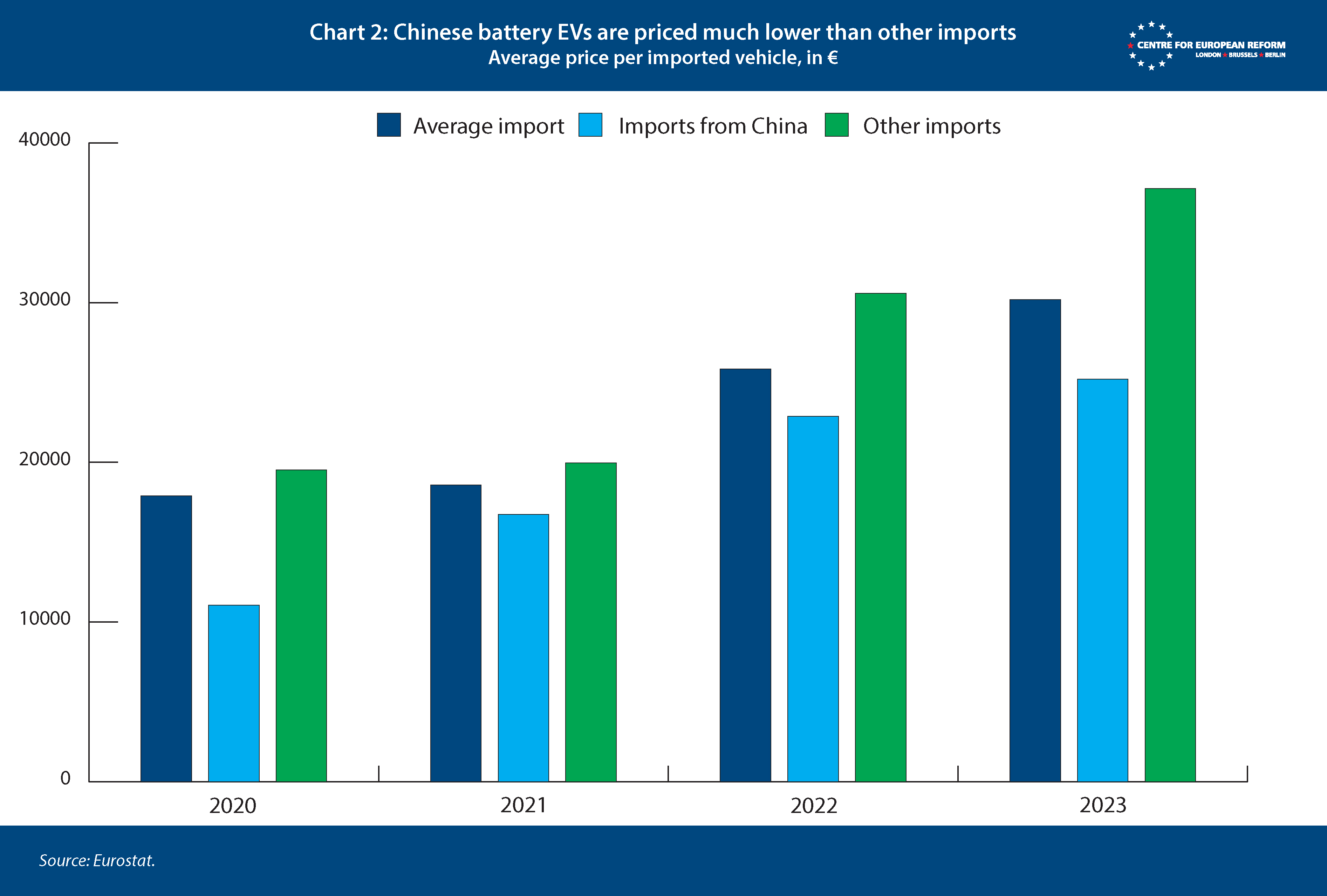

On the face of it, the EU is just the latest Western country targetting Chinese imports. Earlier this year, the Biden administration imposed blanket tariffs on a wide array of Chinese goods, including 100 per cent duties on EVs, effectively closing the US market to Chinese car makers. Canada followed suit in September with similar tariffs on EVs and added duties on steel and aluminium. Turkey also announced a 40 per cent extra tariff. However, the EU’s approach is far more measured, relying on its standard procedure and using a well-established trade defence instrument within the framework of WTO rules. In an era of rising trade unilateralism, this matters: it gives Beijing the option to challenge the decision before the interim WTO appeals tribunal, to which both China and the EU are parties.
Beijing’s response to the EU’s decision was just as swift as it was predictable, condemning the measures as “unfair, unlawful, and unreasonable” and imposing retaliatory tariffs on EU imports of brandy. It also launched its own investigation into French cognac imports and EU pork imports. Europe’s car makers, particularly in Germany, are understandably concerned about the potential for a tit-for-tat trade conflict, though Beijing has incentives to avoid escalating tensions: the EU remains a critical market for Chinese exports.
But it is less clear whether the tariffs are the right solution
Even though the Commission has legitimate concerns, the key question to ask is whether the tariffs can realistically achieve their intended effects: whether they can raise prices of Chinese EVs on the European market and make domestic industry more competitive over the next five years.
The impact on prices is uncertain. In 2023, an average Chinese battery EV imported to Europe was worth 37.4 per cent less than an average EU-produced model, while non-Chinese imports were 7.4 per cent cheaper (Chart 4). True, this gap is substantial, and the tariffs could theoretically narrow it. However, the domestic capacity of China’s EV sector means that most producers are in the position to absorb these costs to maintain a decent market share. EU car makers with production in China, which will be hit by the lower-bound duties, will probably pass higher costs onto European consumers. The main beneficiary, it seems, may be the EU’s purse: in 2023, tariff revenue from Chinese EV imports would have been around €2.3-3 billion.
In 2023, an average Chinese battery EV imported to Europe was worth 37.4 per cent less than an average EU-produced model.
Nor is it clear that these tariffs will make Europe’s nascent EV sector more competitive. European car makers face structural pressures that go far beyond subsidised foreign imports. While state subsidies have contributed to China’s lead in global EV production, fierce domestic competition has also driven Chinese firms to achieve vertical integration, economies of scale, and superior technology, boosted by rising domestic demand and significant investment in infrastructure like charging networks. By contrast, Europe’s battery supply chain is comparatively underdeveloped, leaving the producing costs high, while the slower pace of innovation has left its manufacturers playing catch-up.
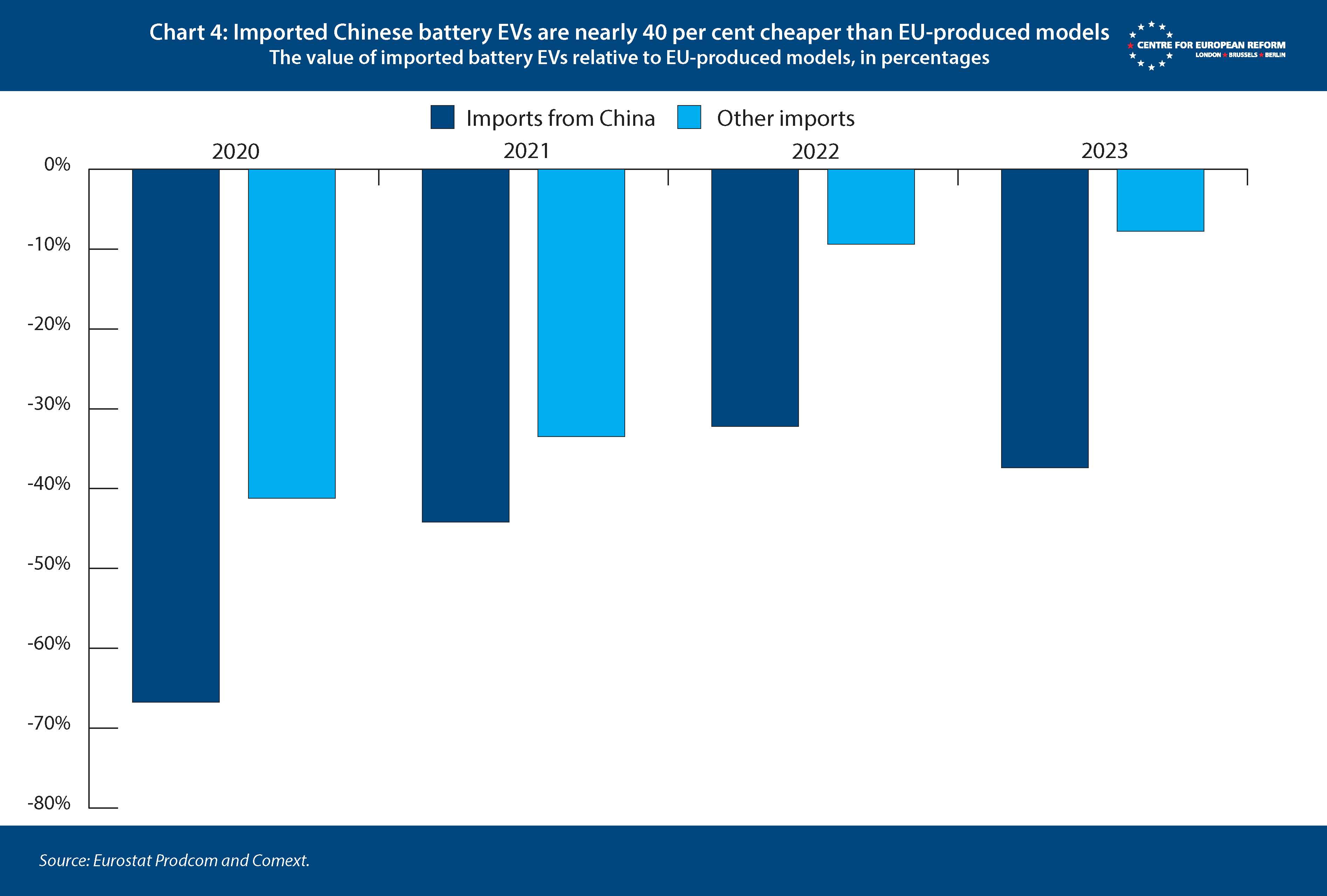
A more likely consequence is that Chinese producers will seek to boost their local presence in the European market. Already, car makers such as Geely and BYD, and battery maker CATL have made substantial investments in EV facilities in Spain, Slovakia and Hungary. For now, Chinese firms seem undeterred by the EU’s new regulatory tools, such as the foreign subsidies regulation that allows Brussels to block companies subsidised by foreign governments from operating in the EU. The strategy of building a local presence – often through joint ventures with European companies – might now accelerate, though Beijing has been vocal in disapproving such corporate strategies. For some European policy-makers, this could be seen as a win-win outcome, increasing production capacity within the EU and creating new local manufacturing jobs. However, it also requires European policy-makers to be more comfortable with state-subsidised Chinese companies becoming more, not less, embedded into the European EV supply chain. Not all European politicians share the same risk appetite, with some being cautious over potential security risks while others welcome Chinese investors with open arms.
The episode has exposed difficult policy trade-offs ahead
Meanwhile, European consumers, who have benefitted from the influx of affordable EVs, may find themselves in the backseat. The reason behind growing consumer demand for Chinese EVs is not the lack of domestic production by Europe’s homegrown brands. In fact, domestic EV production has been growing and maintains over half of the market share. Instead, many European consumers seem attracted to the more affordable – yet technologically competitive – models that Chinese car makers provide. In 2023, Chinese imports accounted for 26 per cent of new battery EV sales in the EU, compared with 19 per cent from other countries and 55 per cent from domestic manufacturers (Chart 5). Tariffs may disproportionately affect price-sensitive buyers – a group European policy-makers are trying to encourage as part of their goal of phasing out new petrol and diesel cars by 2035.

Perhaps inadvertently, this episode has highlighted a more fundamental tension for European policy-makers: between the desire to protect the competitiveness of a ‘strategic industry’ and boost domestic production capacity, while also aiming to help consumers access affordable products and technologies – often imported more cheaply from overseas – that are critical to accelerating the green transition. On paper, these objectives can be neatly reconciled, but in the practical realm of policy-making, they often collide. Chinese EVs have brought these difficult trade-offs into clear focus, but this won’t be the last time that European policy-makers have to face them.
Anton Spisak is an associate fellow at the Centre for European Reform.

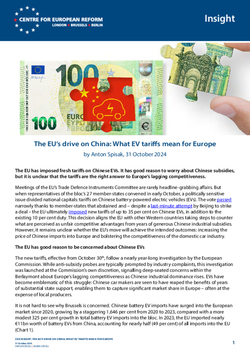
Add new comment